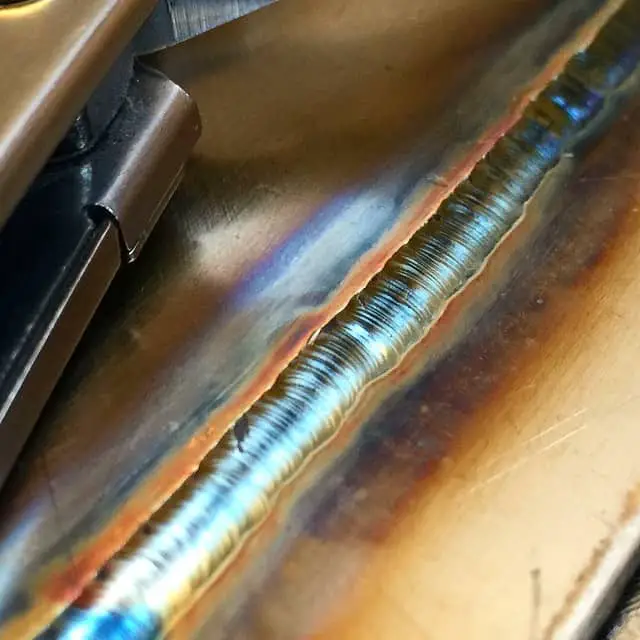This post contains affiliate links to products, services, or education. We may receive a commission for purchases made through links.
Tungsten Inert Gas (TIG) welding is a type of arc welding that uses a tungsten electrode to heat either a filler metal or the base metal being welded together. A lot of people in industries where precision, aesthetic, and strength are crucial prefer to use TIG welding for their projects. It is especially prevalent in the automotive industry. Why is TIG welding preferred for aluminum and stainless steel?
You have a lot more control over the different components of the weld when you use TIG welding. There is more precision in feeding the filler material, raising and lowering the heat, and forming the bond. This results in incredibly clean and strong welds, even when welding thinner or more difficult metals.

When you learn about the process of TIG welding and the advantages that it offers, it’s easy to see why many people take the time to implement it.
Continue reading below to find out more about why TIG welding is the go-to choice for aluminum, stainless steel, and other metals.
Why TIG Welding Is Preferred
Tungsten Inert Gas welding, also known as Gas Tungsten Arc Welding, has several advantages over other forms of welding. When it comes to aluminum and stainless steel, there are a few reasons that TIG welding is the better choice.
TIG Welding Allows More Control
One of the most significant advantages of using TIG welding is the fact that it gives you much more control over the entire process.
This can directly lead to the other benefits listed below. When it comes to fussy metals like aluminum and stainless steel, having as much control as possible is essential.
TIG welding allows for control over the level of heat applied to the metal. Control is crucial with aluminum, which has a lower heating temperature than most metals.
When it comes to stainless steel, managing the heat output aids in preventing oxidation and heat effects.
Filler materials must be added separately during TIG welding. Doing it this way allows the operator to control both the speed and the depth of the weld, making it far more precise. It may take a little more time and practice to achieve, but the quality of the weld makes it worth it.
TIG Welding Is Stronger
When you use TIG welding for thinner metals, it makes for a much stronger weld.
TIG welding creates a stronger bond, another reason why it is preferred for aluminum and stainless steel.
The stronger bond is also why TIG welding is so prevalent in the automotive industry. This added strength is directly related to the level of control that is attainable with TIG welding.
There is overall less disturbance in the metal because the operator can more precisely control the filler metal, which means the beads can be smaller.
The ability to control the level of heat also allows for a stronger bond with fewer necessary reworks.
TIG Welding Is Cleaner

It isn’t always necessary to use a filler material when using TIG welding because it is capable of heating the metal itself to weld it together. When appropriately utilized, this method of welding can lead to a much cleaner bond without sacrificing strength.
If you are using filler material, TIG welding eliminates the normal spatter of other types of welding.
It lowers the need for much of the cleanup work necessary after welding. There is practically no smoke or residue associated with it, making it better for the environment.
The level of control that comes along with TIG welding leads to fewer defects in the weld. You are much less likely to have to go in afterward and clean things up.
This is a huge advantage when it comes to welding more delicate materials.
TIG Welding Produces Better Quality
A quality product is essential.
Welders want their welds to hold up, but they also want them to look professional. TIG welding offers this higher quality even on materials that can be more difficult to weld like aluminum and stainless steel.
The durability of TIG welding is especially attractive with stainless steel, which requires a stronger bond to keep the pieces together.
Having as much control of the welding process as possible makes it perfect to weld this kind of metal. Whenever there is a need for precision, TIG welding offers the highest quality weld for even the smallest of projects.
When to Use TIG Welding
There are certain situations where it is more useful to use TIG welding over MIG welding. It can be difficult to discern which process would be best.
There are some things that can help you make that decision.
It’s best to use TIG welding if…
- You are welding together thin pieces of metal.
- You want the surface of the metal to be as clean as possible after welding.
- A strong, long-lasting weld is necessary.
- You have the time to commit to it.
TIG welding can be used on just about any material. It is incredibly versatile but takes longer to perfect as compared to other forms of welding. If you want a clean, strong weld, then you are better off choosing TIG if possible.
The Difference Between TIG and MIG Welding
TIG and MIG welding are both forms of inert gas welding, though they take different approaches to get the job done. They both use gas to shield the weld pool and the bond during the welding process.
TIG welding, or Tungsten Inert Gas welding, uses a tungsten electrode that is non-consumable.
It is fixed into place and doesn’t run out. This means that any filler material must be fed into the weld pool by hand, requiring much more attention and accuracy.
TIG welding heats the metal, making it possible to weld two pieces of metal without any filler material at all.
MIG welding, or Metal Inert Gas welding, uses a filler material that is continuously fed through the machine.
Its electrode is consumable and must be replaced when it runs out. MIG welding is a much faster process, which makes it preferable for large scale production.
Learning TIG welding is much more difficult than learning MIG welding. When it comes to TIG welding, you have to use both hands as well as your foot to operate the pedal that controls the heat.
All the factors that lead to the precision of TIG welding make it a much more involved process.
The kind of gas used to shield each welding process is also different. TIG welding uses either argon or a mix of argon and helium.
MIG welding uses either carbon dioxide or a mix of carbon dioxide and argon. These gases are necessary for both processes to protect the weld from atmospheric gases.
TIG Welding Results in Quality Welds
Learning a new technique that has more details involved is a big step. TIG welding takes time and energy to learn and implement in your day-to-day production, but it is absolutely worth it.
You can always expect to end up with amazing bonds if you know what you’re doing.
TIG welding is often preferred because of the quality that it results in. Stronger, cleaner and longer-lasting welds make this kind of welding extremely attractive.
A lot of these advantages are achieved because of the level of control the operator is afforded.
If you are hoping to start using TIG welding, it’s important that you take a class to learn everything you need to know about it.
You don’t want to end up ruining your welds because you don’t know how to do it properly. Once you get a handle on it, though, you will be producing high-quality welds in no time.
